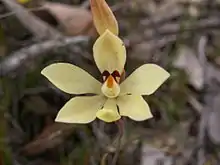Thelymitra antennifera
Thelymitra antennifera, commonly called the rabbit-eared sun orchid, lemon-scented sun orchid or vanilla orchid is a species of orchid which is native to Western Australia, South Australia and Victoria and northern parts of Tasmania.
| Rabbit-eared sun orchid | |
|---|---|
 | |
| Thelymitra antennifera in the Stirling Range National Park. | |
| Scientific classification | |
| Kingdom: | Plantae |
| Clade: | Tracheophytes |
| Clade: | Angiosperms |
| Clade: | Monocots |
| Order: | Asparagales |
| Family: | Orchidaceae |
| Subfamily: | Orchidoideae |
| Tribe: | Diurideae |
| Genus: | Thelymitra |
| Species: | T. antennifera |
| Binomial name | |
| Thelymitra antennifera | |
| Synonyms[1] | |
|
Macdonaldia antennifera Lindl. | |
Description
Thelymitra antennifera is a tuberous, perennial herb, 10–25 cm tall with yellow flowers from July to October.[2] Its leaf is circular in cross–section, 5 to 12 cm long and 2 to 3 mm wide. The inflorescence consists of one to four yellow flowers on a wiry, zig-zagged often pinkish stem. Each flower is 20 to 40 mm across with a lemon or vanilla scent. The sepals and petals are 12 to 20 mm long and 4 to 6 mm wide, the sepals having a broad, reddish–brown band on their outer surface. The column is 5 to 6 mm long and 2 to 3 mm wide with dark brown arms that are ear-like and held high above the column.[3] As with others in the genus, it reproduces by seeds but is unusual in that it is one of the few that develops tubers on the end of stolon-like roots, allowing it to form new colonies.[4] The flowers are insect pollinated and open readily, even on cool days and are long-lasting.[5]
Distribution and habitat
The species occurs in the South–West and Eremaean botanical provinces of Western Australia. It is also found South Australia and Victoria. In Tasmania it only occurs in a few small areas and is classified as an endangered species in that state.[3] Elsewhere it is widespread and common, growing in many habitats, especially shrub, heath and mallee. It sometimes forms dense, extensive colonies, flowering freely, especially after fire.[5]
Taxonomy and naming
The species was first described by John Lindley in 1840 in his A Sketch of the Vegetation of the Swan River Colony (1840) as Macdonaldia antennifera.[6] but was later renamed Thelymitra antennifera by the English botanist Joseph Dalton Hooker in The botany of the Antarctic voyage of H.M. discovery ships Erebus and Terror. III. Flora Tasmaniae[7] The specific epithet (antennifera) is from the Latin antenna, (classically "a sail yard"), and -fer meaning "-bearing", referring to the lateral appendages on the column.[8][9] The genus name Macdonaldia, honours "Mrs. Smith, née Macdonald, a lady who has examined the Orchidaceous plants of that island with great care, and from whom a most beautiful series of dried specimens has reached me through the offices of Mr. Gunn".[10]
Five hybrids are recognised–
- Thelymitra antennifera (Lindl.) Hook.f. x Thelymitra gregaria D.L.Jones & M.A.Clem.[11]
- Thelymitra antennifera (Lindl.) Hook.f. x Thelymitra luteocilium Fitzg.[12]
- Thelymitra antennifera (Lindl.) Hook.f. x Thelymitra macrophylla Lindl. crimson sun orchid[13]
- Thelymitra antennifera (Lindl.) Hook.f. x Thelymitra maculata Jeanes western wheatbelt sun orchid[14]
- Thelymitra antennifera (Lindl.) Hook.f. x Thelymitra vulgaris Jeanes scarce sun orchid[15]
Use in horticulture
Thelymitra species are readily cultivated in pots.[16]
References
- "Thelymitra antennifera". World Checklist of Selected Plant Families (WCSP). Royal Botanic Gardens, Kew.
- "Thelymitra antennifera L.f." FloraBase. Western Australian Government Department of Parks and Wildlife.
- "Thelymitra antennifera - rabbit ears; Tasmanian threatened species listing statement". Tasmanian threatened species section—Department of primary industries, parks, water and environment. Retrieved 23 January 2015.
- "Thelymitra antennifera". Lucid keys. Retrieved 2 June 2017.
- Jones, David L. (2006). A complete guide to native orchids of Australia including the island territories. Frenchs Forest, N.S.W.: New Holland. pp. 246–247. ISBN 9781877069123.
- "Macdonaldia antennifera Lindl". Australian Plant Name Index (APNI), IBIS database. Centre for Plant Biodiversity Research, Australian Government.
- "Thelymitra antennifera (Lindl.) Hook.f." Australian Plant Name Index (APNI), IBIS database. Centre for Plant Biodiversity Research, Australian Government.
- Francis Aubie Sharr (2019). Western Australian Plant Names and their Meanings. Kardinya, Western Australia: Four Gables Press. p. 131. ISBN 9780958034180.
- Brown, Andrew; Dixon, Kingsley; French, Christopher; Brockman, Garry (2013). Field guide to the orchids of Western Australia : the definitive guide to the native orchids of Western Australia. Simon Nevill Publications. p. 436. ISBN 9780980348149.
- Lindley, John (1840). A Sketch of the Vegetation of the Swan River Colony. London: James, Ridgway. p. l. Retrieved 28 September 2019.
- "Thelymitra antennifera (Lindl.) Hook.f. x Thelymitra gregaria D.L.Jones & M.A.Clem.". APNI. Retrieved 9 June 2018.
- "Thelymitra antennifera (Lindl.) Hook.f. x Thelymitra luteocilium D.L.Jones & M.A.Clem.". APNI. Retrieved 9 June 2018.
- "Thelymitra antennifera (Lindl.) Hook.f. x Thelymitra macrophylla D.L.Jones & M.A.Clem.". APNI. Retrieved 9 June 2018.
- "Thelymitra antennifera (Lindl.) Hook.f. x Thelymitra maculata D.L.Jones & M.A.Clem.". APNI. Retrieved 9 June 2018.
- "Thelymitra antennifera (Lindl.) Hook.f. x Thelymitra vulgaris D.L.Jones & M.A.Clem.". APNI. Retrieved 9 June 2018.
- Wrigley, John W.; Fagg, Murray (1983). Australian native plants : a manual for their propagation, cultivation and use in landscaping (2nd ed.). Sydney: Collins. p. 494. ISBN 0002165759.
External links
 Media related to Thelymitra antennifera at Wikimedia Commons
Media related to Thelymitra antennifera at Wikimedia Commons